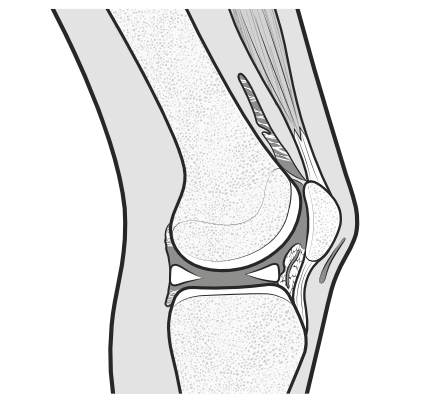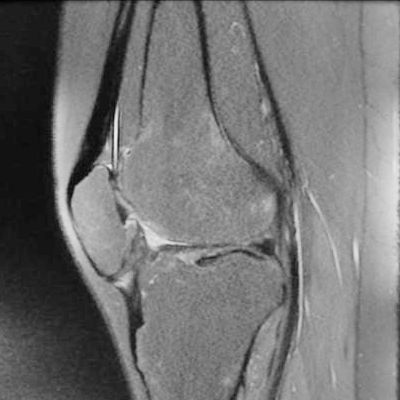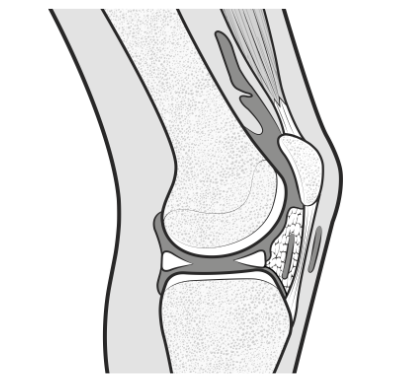Patella baja is a kneecap that is positioned abnormally low in relation to the groove of the femur. It is also known as patella infera or infrapatellar contracture syndrome.
 Page content approved November 2023 by Dr Lars Blond (Knee Surgeon)
Page content approved November 2023 by Dr Lars Blond (Knee Surgeon)

Adhesions developing in the suprapatellar pouch, posterior capsule and anterior interval may create flexion loss, extension loss or both.

Matured scar tissue has contracted, closing the important spaces that normally allow movement, and pulling the kneecap right down.
Who gets patella baja?
Some people are born with an atypically low patella, but more often it is a complication of injury or surgery. An abnormally low patella - patella baja (also called patella infera) - is a common complication of total knee replacement or opening-wedge tibial osteotomy due to inflammation and scarring within the front of the knee joint and behind the patellar tendon - in the region known as the anterior interval. It may also be seen in any other condition where 'arthrofibrosis' has been triggered in the anterior interval, such as following joint infection or a long period of knee immobilisation, after quadriceps muscle weakness, fractures of the tibia, and any other cause of arthrofibrosis inside the knee.
What are the consequences of patella baja
The abnormal position causes more pressure onto the edge of the kneecap, which may lead to considerable pain, as the kneecap impinges against the tibia when the knee bends - and arthritic changes can occur at the back of this bone. If patella baja is not adequately managed it can lead to decreased range of motion (ROM) in both flexion and extension, inability to fully straighten the knee, impingement with anterior knee pain and possibly rupture of the patellar tendon.

Monitoring patella baja
Because the scarring of arthrofibrosis of the anterior interval tugs the patella down, serial X-rays of kneecap position can help the surgeon to evaluate deterioration in the arthrofibrotic condition and the need for surgical intervention such as lysis of adhesions and anterior interval release.
Interventions for patella baja
By the time patella baja has developed, it is likely already too late for interventions such as patellar mobilisations and manipulation under anaesthesia. The surgeon may try to surgically release the scar tissue with anterior interval release. If these measures fail, and the patient remains symptomatic, surgical options may include:
- excision of the lower third of the patella
- patellar tendon lengthening
- reconstruction of the patellar tendon with allograft
- tibial tubercle transfer (to a more proximal position)
- patellectomy (salvage situation)
Quick links
Forum discussions
- Question about Patella Baja
Discussing the symptoms of patella baja.
Peer-reviewed papers
-
Quote:
"Treatment strategies include tibial tubercle proximalization, patellar tendon lengthening, and patellar tendon reconstruction. Allografts and autografts can be utilized..."
Citation: Barth KA, Strickland SM. Surgical Treatment of Iatrogenic Patella Baja. Curr Rev Musculoskelet Med. 2022 Dec;15(6):673-679. doi: 10.1007/s12178-022-09806-y. Epub 2022 Nov 29. PMID: 36445621; PMCID: PMC9789255.
Relevant content -
- Adhesions
- Anterior interval arthrofibrosis
- Infrapatellar contracture syndrome
- Patellar mobilisations
- Manipulation under anaesthesia
- Anterior interval release
 2006 - Infrapatellar contracture syndrome - by Dr Peter J Millett (Knee Surgeon)
2006 - Infrapatellar contracture syndrome - by Dr Peter J Millett (Knee Surgeon)
 2008 - reviewed 2023 - Patellofemoral pain - by Dr Ronald Grelsamer (Knee Surgeon)
2008 - reviewed 2023 - Patellofemoral pain - by Dr Ronald Grelsamer (Knee Surgeon)
Peer-reviewed paper -
- 1991 - The early diagnosis and treatment of developmental patella infera syndrome - Authors: Noyes FR et al. and summarised for our readers by Dr Sheila Strover (Clinical Editor)

 2008 -
2008 -